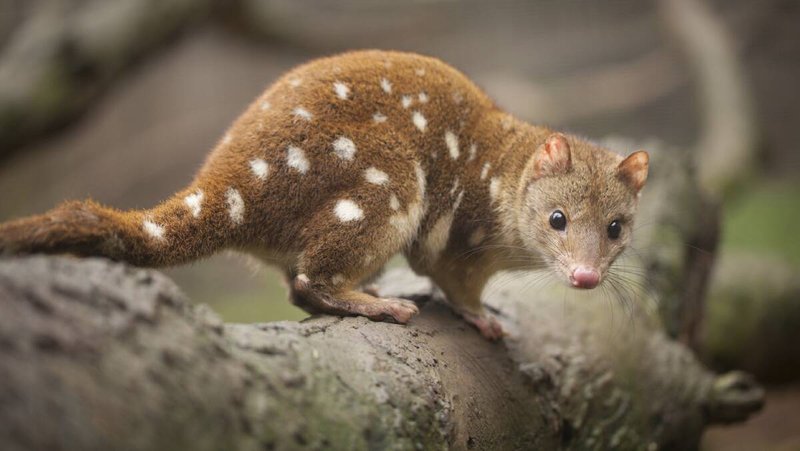
You might not have heard of the Tiger Quoll, but these fascinating little creatures play a crucial role in Australia’s ecosystem. Imagine a cute, spotted cat, but instead of meowing, it’s a skilled hunter navigating the underbrush of its forest home. The Tiger Quoll is a marsupial that blends charm with cunning, making it a unique species worth knowing about.
These animals are not only captivating in appearance but also rich in personality. With their striking patterns and agile movements, Tiger Quolls can thrive in various environments, showcasing their adaptability. If you’re curious about their habitat, diet, and behavior, let’s dive into everything you need to know about the Tiger Quoll.
What is a Tiger Quoll?
The Tiger Quoll (Dasyurus maculatus) is one of the largest marsupial carnivores in Australia. These intriguing animals feature a coat covered in distinctive white spots, which give them a striking appearance. Their size can range from about 50 to 70 centimeters long, making them relatively small but quite agile. They hold an essential role in the ecosystem as both predator and prey.
What makes the Tiger Quoll particularly interesting is its behavior and lifestyle. Unlike some other marsupials that prefer to stay close to the ground, Tiger Quolls are skilled climbers, often found perched on trees or exploring rocky outcrops. This adaptability helps them hunt a variety of prey, which includes small mammals, birds, and insects. You could say they are the multi-talented performers of their woodland stage.
These animals are also known for their vocalizations, which can range from growls to high-pitched whistles. Communicating in this way not only helps them communicate with each other but also signals their presence to potential competitors. With such a unique personality, it’s easy to see why many people are captivated by the Tiger Quoll.
Physical Characteristics
Tiger Quolls are equipped with several distinctive physical features that set them apart from other marsupials. Their fur is typically a rich, tawny brown covered with white spots, which serve as excellent camouflage against the dappled light of their forest homes. These spots can sometimes appear to be more prominent on younger quolls, fading slightly as they mature. Their long, pointed snouts and sharp teeth highlight their carnivorous diet, as they are designed for hunting.
In terms of size, adult Tiger Quolls weigh between 4 to 8 kilograms, depending on their gender and habitat. Males are generally larger than females, a trait known as sexual dimorphism. They boast strong, muscular bodies that provide the agility needed for climbing and hunting. With their powerful limbs and retractable claws, Tiger Quolls are adept at navigating their environment.
Another remarkable feature is their tail, which can be as long as their body. This long, bushy tail helps them maintain balance while climbing and hunting, acting almost like a stabilizer. Additionally, their keen sense of smell and sharp eyesight make them effective hunters, allowing them to detect prey even in low light conditions. Overall, the Tiger Quoll is truly a fascinating example of nature’s design.
Habitat and Distribution
You can find Tiger Quolls in various habitats across Australia, thriving in moist forests, woodlands, and even grasslands. They prefer areas with ample tree cover, as this not only provides shelter but also hunting opportunities. Tiger Quolls are typically found in eastern Australia, from northern Queensland down to southern Victoria and Tasmania. However, their distribution has become limited over the years due to habitat loss and other environmental pressures.
The key to understanding their habitat is recognizing their need for a mix of tree cover and open space. They rely on trees for climbing to escape predators and for hunting smaller animals. Unfortunately, as urban development and agriculture continue to encroach upon their natural habitats, Tiger Quoll populations have started to decline. Preserving these areas is vital for their survival.
You might be wondering how Tiger Quolls adapt to their environment if it changes. These resilient creatures are known to alter their hunting techniques based on the availability of prey and their surroundings. For instance, during times when food is scarce, they might venture further from their usual territory to find sustenance. This adaptability highlights their importance in the ecosystem, as they fill a crucial niche as both predator and prey.
| Feature | Description |
|---|---|
| Scientific Name | Dasyurus maculatus |
| Size | 50 to 70 centimeters in length |
| Weight | 4 to 8 kilograms |
| Habitat | Moist forests, woodlands, and grasslands |
| Diet | Small mammals, birds, and insects |
| Lifespan | 5 to 10 years in the wild |
| Distribution | Eastern Australia and Tasmania |
Diet and Hunting Behavior
The diet of the Tiger Quoll is as diverse as its habitat. These marsupials are primarily carnivorous, preying on a range of animals, including small mammals, birds, and insects. They are considered opportunistic feeders, meaning they’ll take advantage of whatever food source is available. This flexibility is key to their survival, especially as prey availability can fluctuate.
When hunting, Tiger Quolls rely on their keen senses. Their sharp eyesight helps them spot potential prey from a distance. And with their excellent sense of smell, they can track down hiding animals, even when they’re tucked away in burrows or dense vegetation. Imagine a game of hide and seek where the Tiger Quoll has a distinct advantage!
Once they locate their prey, Tiger Quolls are quick and stealthy. They stalk quietly, using their speed and agility to close the gap before pouncing. Their sharp teeth are designed for gripping and tearing meat, allowing them to consume their catch efficiently. Interestingly, they often cache their food, hiding it in tree hollows or underbrush to eat later. This behavior not only secures their meals but also showcases their smart survival skills.
Reproduction and Lifespan
Reproduction in Tiger Quolls is a fascinating event that occurs once a year, typically in late winter or early spring. The breeding season is marked by vocalizations and displays, as males compete for the attention of females. After a gestation period of around 21 days, females give birth to 2 to 6 tiny, underdeveloped young. These little ones climb into the mother’s pouch, where they continue to develop for about 10 weeks.
After their pouch life, the young quolls emerge but continue to nurse for another month or so. It’s during this time that they start learning essential survival skills, like hunting and climbing. Mothers are incredibly attentive, teaching their young what it takes to thrive in the wild. The bond between mother and offspring is vital, as it lays the foundation for the young quolls’ future independence.
In terms of lifespan, Tiger Quolls can live anywhere from 5 to 10 years in the wild, although some can live longer in captivity. Their relatively short lifespan makes their reproductive success essential for maintaining healthy populations. Unfortunately, habitat loss and environmental pressures have significantly impacted their numbers, making conservation efforts increasingly critical.
Conservation Status
The conservation status of the Tiger Quoll is of great concern. These beautiful marsupials are classified as ‘Near Threatened’ by the International Union for Conservation of Nature (IUCN). Their populations have dwindled over the years due to habitat destruction, competition with invasive species like foxes and feral cats, and, of course, human activities.
To combat this decline, various conservation efforts are underway. Protected areas are being established to safeguard their natural habitats, and habitat restoration projects are being initiated to help resettle those lost populations. Additionally, education and awareness-raising initiatives aim to inform the public about the importance of these unique animals and the ecological roles they play.
As advocates for wildlife, you can help support Tiger Quoll conservation by spreading the word, participating in local conservation initiatives, or even contributing to organizations dedicated to protecting Australia’s natural heritage. Every little bit counts, and your involvement can make a real difference in the future of these splendid creatures.
Behavior and Social Structure
Understanding the behavior and social structure of Tiger Quolls reveals a lot about their lives. These animals are typically solitary, preferring to go about their business without the distraction of others. However, during the breeding season, males may compete for the attention of females, leading to temporary social interactions. They communicate through a series of calls and vocalizations, indicating their presence and intentions to other quolls.
Interestingly, Tiger Quolls are known to be nocturnal hunters, which means they do most of their activity at night. This lifestyle not only reduces competition for food but also allows them to take advantage of the many small creatures that are active during those hours. You can often hear their calls echoing through the forest at night, a reminder that they are close by.
While they are generally solitary, Tiger Quolls can sometimes be seen foraging together, especially when food is abundant. This behavior indicates a level of flexibility in their social structures, which may vary based on environmental conditions and food availability. Observing these interactions can shed light on how they adapt to their surroundings and depend on each other for survival.
FAQ
What is the Tiger Quoll’s main threat in the wild?
One of the biggest threats to the Tiger Quoll is habitat loss due to deforestation and urban development. Additionally, competition with invasive species like feral cats and foxes poses a significant danger to their survival. These factors combined have led to a decline in their population across Australia.
How do Tiger Quolls communicate with each other?
Tiger Quolls use a variety of vocalizations, including growls, whistles, and chirps, to communicate with each other. These sounds serve various purposes, such as attracting mates or signaling territory. Understanding their vocalizations can provide insight into their social interactions and behaviors.
Are Tiger Quolls dangerous to humans?
Generally, Tiger Quolls are not dangerous to humans. They tend to avoid contact with people and are more focused on hunting smaller prey. However, like any wild animal, they should be respected and observed from a distance to ensure both their safety and ours.
What do Tiger Quolls eat?
The diet of the Tiger Quoll mainly consists of small mammals, birds, and insects. They are opportunistic feeders and will take advantage of whatever food sources are available, showcasing their adaptability as they hunt in various environments.
How long do Tiger Quolls live in the wild?
Tiger Quolls typically have a lifespan of 5 to 10 years in the wild. Their relatively short lifespan makes reproductive success crucial for sustaining their populations, especially considering the environmental pressures they face.
Can you keep a Tiger Quoll as a pet?
No, Tiger Quolls are wild animals and are not suitable as pets. They have specific habitat needs and social behaviors that cannot be met in a domestic setting. It’s best to appreciate them in their natural environment and support conservation efforts to protect their species.
Are Tiger Quolls found outside of Australia?
Tiger Quolls are native to Australia and Tasmania and are not found naturally outside of these areas. Their specific habitat requirements and ecological role make them unique to this region, further emphasizing the need for conservation in their native environments.
How can I help save the Tiger Quoll?
You can support Tiger Quoll conservation by raising awareness about their plight, participating in local conservation initiatives, or donating to organizations dedicated to protecting Australia’s wildlife. Every action counts when it comes to preserving the unique species that inhabit our planet.

